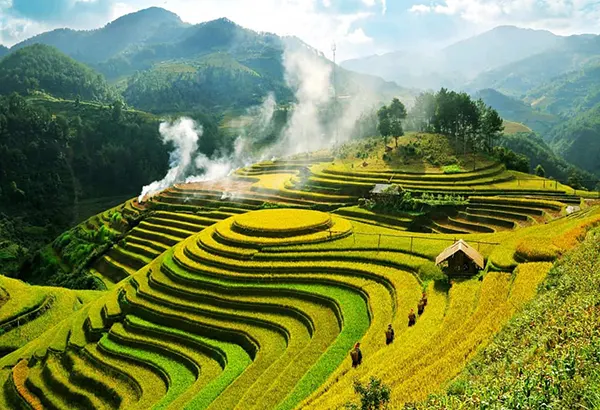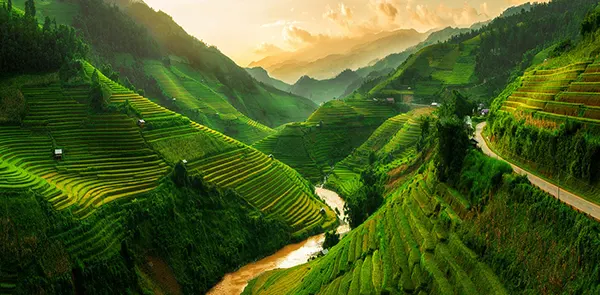Sapa – a Fairy-Tale Mountain Destination in Vietnam with Ethnic Flavour

Located in the misty north-western highlands of Vietnam, Sapa is a small mountain town that enchants visitors with its dramatic landscapes and rich ethnic culture. Known for its emerald rice terraces, imposing peaks like Fansipan, and colourful minority tribes, Sapa offers an authentic glimpse into Vietnam’s mountainous soul. The region is especially attractive to travellers seeking both natural beauty and deep-rooted traditions that remain intact despite modern tourism.
Scenic Landscapes and Breathtaking Altitudes
The hallmark of Sapa is its terraced rice fields, cascading down the hillsides like green stairways to the valley floor. These terraces, particularly stunning between May and October, are the lifeblood of the local economy and a visual delight for photographers and trekkers alike. The patterns carved by generations of ethnic farmers create a unique harmony between humans and nature.
Above the clouds stands Mount Fansipan, Vietnam’s highest peak at 3,147 metres. Known as the “Roof of Indochina,” Fansipan has become more accessible thanks to a modern cable car, which offers breathtaking views of the valleys, forests and distant mountain ranges. For adventurers, multi-day treks still remain a popular choice for summiting this iconic giant.
Sapa’s climate adds to its allure. Cool temperatures, misty mornings and clear afternoons combine to create a refreshing contrast to Vietnam’s tropical lowlands. In winter, the town can even receive light snow – a rare phenomenon in Southeast Asia – drawing crowds eager to experience a snowy landscape in Vietnam.
Hiking Trails and Eco-Adventures
Sapa is a hiker’s paradise, with countless trails weaving through valleys, forests and traditional villages. Popular routes include the trek to Lao Chai and Ta Van villages, which pass through rice fields and bamboo groves while offering encounters with Hmong and Giay ethnic minorities. These treks vary in difficulty, making them suitable for both beginners and seasoned hikers.
Eco-tourism initiatives are on the rise, with homestays operated by local families offering visitors an immersive experience. Spending the night in a stilt house, learning to cook traditional meals, or participating in local festivals gives tourists a deeper understanding of highland life. It’s a sustainable model that supports local communities while offering authenticity to travellers.
Adventure seekers can also explore the nearby waterfalls, such as Silver Waterfall and Love Waterfall, both located within short driving distances. These sites provide not just natural beauty but also insight into local folklore, as many waterfalls are steeped in legends passed down through generations.
Cultural Heritage and Ethnic Diversity
Sapa is home to a remarkable mix of ethnic groups, including the Black Hmong, Red Dao, Tay, Giay, and Xa Pho. Each group contributes to the region’s vibrant culture through their unique clothing, languages, and customs. Walking through the streets or markets of Sapa, one encounters women in indigo-dyed garments, headscarves adorned with silver coins, and hand-embroidered fabrics that take weeks to complete.
The Saturday Love Market is one of the most iconic cultural events. Originally a meeting point for young people from different tribes to court each other, the market has evolved into a colourful bazaar where traditional music, handmade crafts and local cuisine converge. Despite increased tourism, many of these traditions are preserved and respected.
Handicrafts remain a crucial part of life in Sapa. Textile weaving, indigo dyeing and silver jewellery making are skills passed through generations. Visitors can purchase these crafts at local markets or directly from artisans in the villages, ensuring fair trade and cultural preservation.
Festivals and Traditions
Each ethnic group in Sapa celebrates a variety of festivals throughout the year. Tet (Vietnamese New Year) is widely observed, but other celebrations like the Gau Tao festival of the Hmong people and the Cap Sac coming-of-age ceremony of the Dao community offer unique insights into highland spirituality and community bonds.
These festivals often include music, dance, and ritual ceremonies designed to honour ancestors or pray for harvests. Tourists visiting during these events witness authentic cultural expressions that are deeply rooted in animist beliefs and ancestral worship. These traditions are rarely altered for visitors, maintaining their original character.
Music plays a central role in ethnic traditions. Instruments like the khen (a bamboo pipe organ) and traditional drums are used in communal celebrations and rituals. Songs, often performed in native dialects, convey stories of love, hardship and nature, preserving oral histories in melody form.

Modern Development and Sustainable Tourism
In recent years, Sapa has undergone significant development to accommodate growing tourism. New hotels, better roads and improved infrastructure have made the area more accessible. However, this expansion also presents challenges, such as preserving the authenticity of village life and protecting the fragile environment from over-tourism.
Efforts are being made to balance growth with sustainability. The government and NGOs are working with local communities to implement eco-tourism guidelines, waste management practices, and cultural preservation initiatives. Homestay certifications and community-based tourism training are helping to create a model where tourism benefits both visitors and residents.
Visitors are encouraged to travel responsibly – respect local customs, minimise plastic use, and choose tours that directly support indigenous groups. Responsible tourism in Sapa means more than just sightseeing; it means participating in the preservation of one of Vietnam’s most culturally rich and environmentally sensitive regions.
How to Get There and Best Time to Visit
Travellers can reach Sapa from Hanoi via the Lao Cai Express train or by direct bus and limousine services, with the journey taking around 5–6 hours. The final leg from Lao Cai to Sapa offers stunning mountain views as the road winds through dramatic passes and mist-covered hills.
The best time to visit Sapa is from March to May or September to November, when the weather is stable and the rice fields are at their most vibrant. April offers blooming flowers and mild temperatures, while October showcases golden terraces ready for harvest – a dream for photographers.
Accommodation ranges from luxury resorts to simple homestays. Booking in advance is recommended during peak months. Most tourists spend 3–5 days in the area, which is ideal for trekking, cultural immersion and scenic relaxation in one of Vietnam’s most iconic highland destinations.
